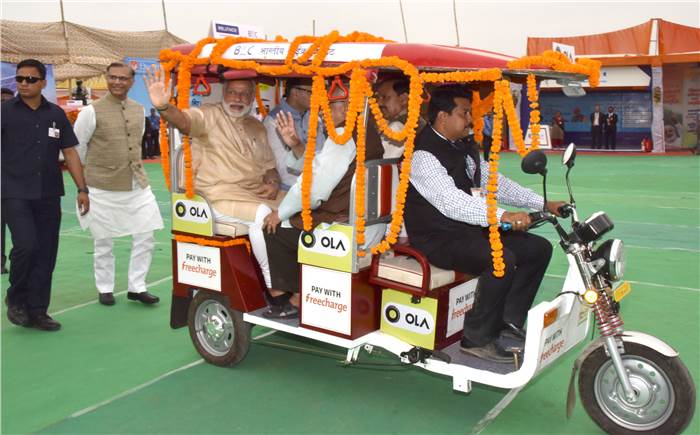A survey has revealed that India is home to approximately 1.5 million electric three-wheeler rickshaws. To put that into perspective, China has had lesser electric passenger car sales than that since 2011. These sales, however, were largely helped by subsidies provided by the Chinese government to encourage such sales. On the other hand, India hardly had any help from its government while these staggering numbers were achieved.
Drivers of the regular fuel-powered rickshaws have discovered that e-rickshaws are quicker, quieter and easier to keep running. Needless to say, they also require less effort to use than the pedal-powered rickshaws. This results in more rides daily and lesser effort for the driver, making e-rickshaws a rather beneficial investment.
A.T. Kearney, a consulting firm, conducted a survey and found that close to 11,000 new e-rickshaws are sold on a monthly basis in the country. They also predict that annual sales can be expected to increase by 9 percent by 2021. The three-wheeler vehicles constitute a $1.5 billion market, controlled by manufacturers like Mahindra & Mahindra Ltd. and Kinetic Engineering Ltd. Various third parties are also involved in assembling the vehicles from parts imported from China.
Providing a further boost to the e-rickshaw market in the country are startups like SmartE, which is a ride-hailing service that employs over 800 e-rickshaws around New Delhi. Goldie Shrivastava, CEO and co-founder of SmartE believes when looking at electric mobility, the focus should be on whether the government is enabling products that are designed for the future.
Elsewhere, Ola, India’s largest ride-hailing startups, has plans to employ 10,000 e-rickshaws in its fleet by April 2019.
In spite of being the fourth-largest automobile market in the world, campaigns to boost private electric car possession have largely failed. The government possibly scaled back the campaigns because it is afraid of disrupting an industry that contributes close to 7 percent of the gross domestic product, as per a Bloomberg NEF report in March. In this sector, China is far ahead of India. As a result of the subsidies provided by the Chinese government while purchasing an electric car, it is estimated that 1.35 million electric passenger vehicles have been sold. As per the Bloomberg NEF, India has only 6,000 privately owned EVs, while China sells more electric cars than that in three days. Maruti Suzuki India Ltd. Is India’s largest automaker, and yet it has stated its first EV won’t go on sale until at least 2020.
Prime Minister Narendra Modi’s administration is currently focusing on promoting electric vehicles to be included in public transportation and fleets, with emphasis on two-wheelers and three-wheelers, taxis and buses. The Ministry of Finance is in the process of finalising a plan to spend approximately $600 million over a period of five years to upgrade the country’s charging infrastructure as well as to provide better subsidies on electric buses. NITI Aayog is a government policy institute that is helping in the formulation of this strategy. Its CEO, Amitabh Kant, has gone on record saying, “India needs to focus on electrifying two-wheelers and three-wheelers.”
With the World Health Origination listing India as being home to 10 of the world’s most polluted cities, the country's increasing air pollution makes yet another strong case for higher adoption of e-rickshaws in the country.
One of the biggest setbacks to the growth of EVs in India is the dearth of charging and battery-swap stations. By the end of 2017, India had just 425 public charging stations. Government and private initiatives are expected to boost this number to 2,800 by 2022, according to BNEF.
However, some companies aren't waiting for the government and are starting to build their own infrastructure. SmartE and Delhi Metro Rail Corp. have struck a deal to provide charging points for e-rickshaws near 10 stations, with plans to cover all 214 stations by the end of 2020.
Shishir Agrawal, the managing director of ShiganeVoltz Ltd., the parent company of GreenRick, an e-rick manufacturer, believes that another hurdle in the market is the absence of bank financing for the traditional rickshaw operators, who are typically low-income workers. If this issue is resolved, he believes it could be possible for the Gurgaon-company to produce 1,000 e-ricks a month. He says that the market has the potential for 20 million sales on an annual basis.
Agrawal added: “If the subsidies get better and easy financing options become available, this market is unstoppable.”




Comments
Member Login
Personal Details
No comments yet. Be the first to comment.